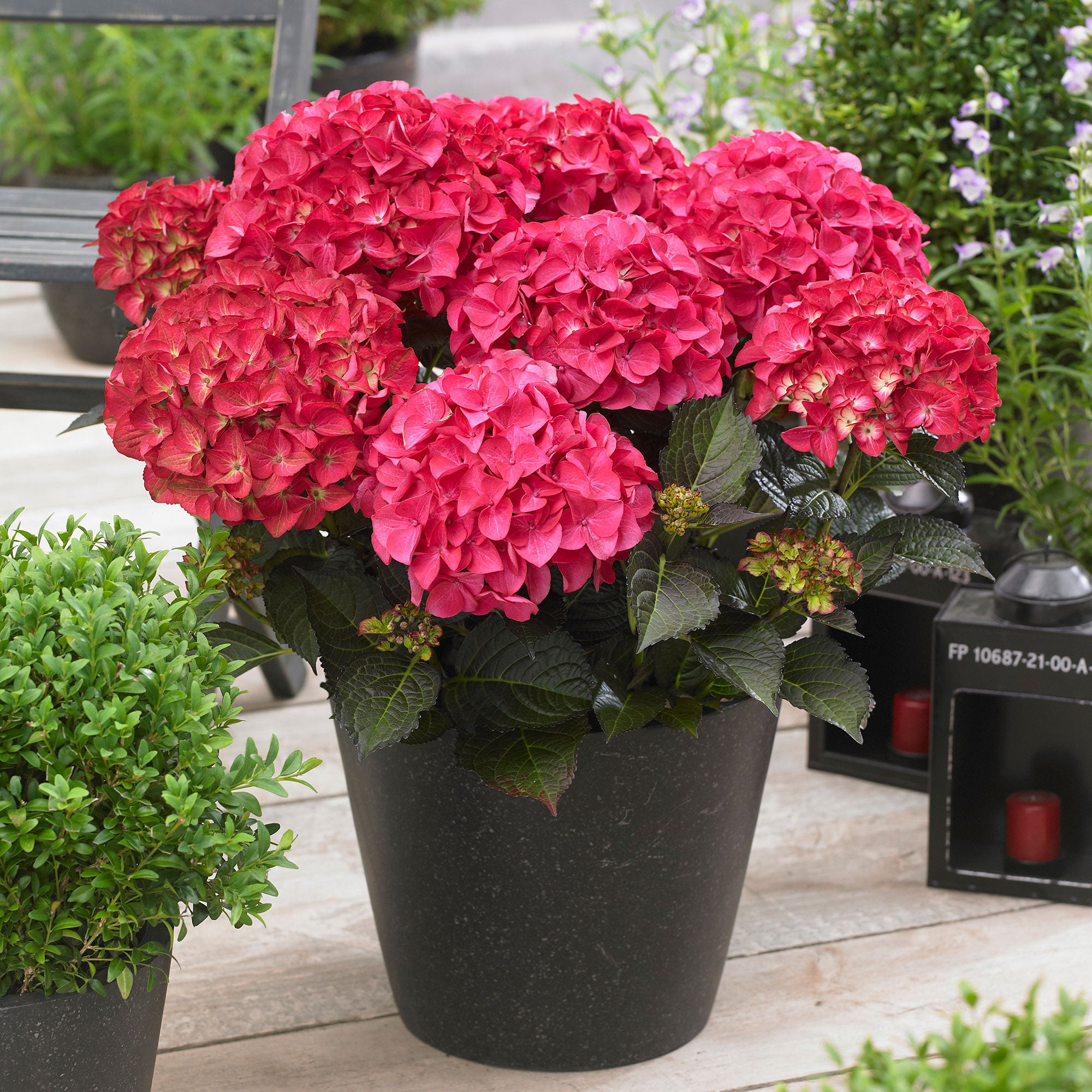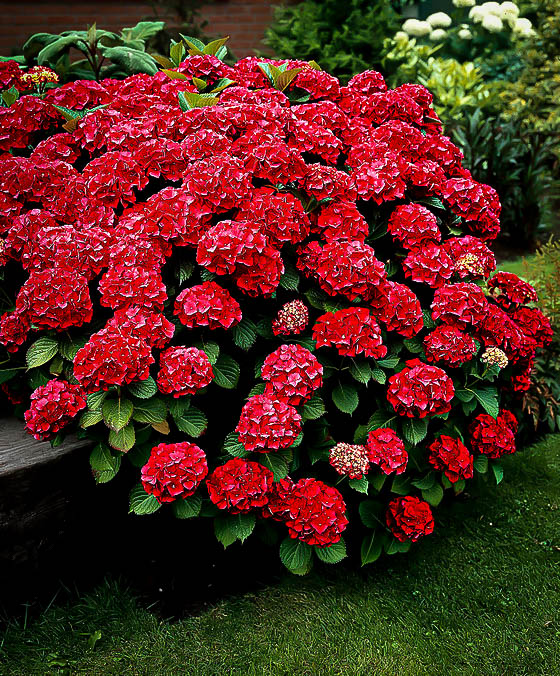The Stunning Hydrangea Macrophylla Red: A Musthave For Your Garden
The Stunning Hydrangea Macrophylla Red: A Must-Have for Your Garden
Hydrangea macrophylla red is a beautiful and versatile shrub that can add a touch of elegance to any garden. With its large, deep red blooms, this hydrangea is sure to turn heads.
Introduction
Hydrangea macrophylla red is a deciduous shrub that can grow up to 6 feet tall and wide. It has large, dark green leaves and produces large, mophead-shaped blooms in shades of red from mid-summer to early fall. The color of the blooms can vary depending on the pH of the soil. In acidic soil, the blooms will be a deep blue, while in alkaline soil, they will be pink.
Hydrangea macrophylla red is a relatively easy plant to care for. It prefers full sun to partial shade and moist, well-drained soil. It is important to water hydrangeas regularly, especially during hot, dry weather. To encourage blooms, fertilize hydrangeas with a balanced fertilizer in the spring.
Main Content
Planting Hydrangea Macrophylla Red
The best time to plant hydrangea macrophylla red is in the spring or fall. When choosing a location, select a spot that receives full sun to partial shade. The soil should be moist, well-drained, and slightly acidic. If your soil is alkaline, you can amend it with peat moss or sulfur to lower the pH.
Dig a hole that is twice as wide and as deep as the root ball of the hydrangea. Place the plant in the hole and backfill with soil, tamping down gently. Water the plant thoroughly.
Caring for Hydrangea Macrophylla Red
Hydrangea macrophylla red is a relatively low-maintenance plant. However, there are a few things you can do to keep it healthy and blooming.
- Water regularly, especially during hot, dry weather.
- Fertilize with a balanced fertilizer in the spring.
- Deadhead spent blooms to encourage new growth.
- Mulch around the plant to help retain moisture and suppress weeds.
Pests and Diseases
Hydrangea macrophylla red is generally resistant to pests and diseases. However, it can be susceptible to aphids, scale, and powdery mildew. If you notice any pests or diseases, treat them immediately with an appropriate pesticide or fungicide.
Propagation
Hydrangea macrophylla red can be propagated by cuttings or division. To propagate by cuttings, take 4-6 inch cuttings from healthy stems in the spring or summer. Dip the cuttings in rooting hormone and plant them in a well-draining potting mix. Keep the cuttings moist and in a warm, bright location. They should root in 4-6 weeks.
To propagate by division, dig up a mature hydrangea plant in the spring or fall. Use a sharp knife or spade to divide the plant into two or more sections. Each section should have at least a few roots and some leaves. Plant the divisions in separate holes and water them well.
Conclusion
Hydrangea macrophylla red is a beautiful and versatile shrub that can add a touch of elegance to any garden. With its large, deep red blooms, this hydrangea is sure to turn heads. It is relatively easy to care for and can be propagated by cuttings or division. If you are looking for a stunning and easy-care shrub for your garden, hydrangea macrophylla red is a great choice.
If you're looking for a beautiful and hardy shrub that will add a splash of color to your garden, then the hydrangea macrophylla red is a great option. These shrubs can grow up to 6 feet tall and wide, and they produce large, showy flowers in shades of red, pink, and purple. Hydrangea macrophylla reds are relatively easy to care for, and they prefer partial shade and moist soil.
If you're interested in learning more about hydrangea macrophylla reds, I recommend visiting . This website has a wealth of information about these shrubs, including plant profiles, care tips, and even recipes for using hydrangea flowers in cooking. You can also find a directory of nurseries that sell hydrangea macrophylla reds.
FAQ of hydrangea macrophylla red
- What are the best growing conditions for Hydrangea macrophylla red?
Hydrangea macrophylla red grows best in moist but well-drained soil in full sun to partial shade. It is important to protect the plant from cold, drying winds. To promote fresh, new, vigorous growth on established plants, cut back hard in early spring.
- What is the pH of the soil for Hydrangea macrophylla red?
The pH of the soil for Hydrangea macrophylla red should be between 5.5 and 6.5. If the soil is too alkaline, the flowers will be blue. If the soil is too acidic, the flowers will be pink. You can test the pH of your soil using a pH testing kit.
- How much water does Hydrangea macrophylla red need?
Hydrangea macrophylla red needs to be watered regularly, especially during hot, dry weather. The soil should be kept moist, but not soggy.
- How do I fertilize Hydrangea macrophylla red?
Hydrangea macrophylla red should be fertilized in the spring and fall. Use a balanced fertilizer, such as 10-10-10, at the rate recommended on the fertilizer label.
- How do I prevent pests and diseases in Hydrangea macrophylla red?
To prevent pests and diseases in Hydrangea macrophylla red, it is important to keep the plant healthy. This means watering it regularly, fertilizing it properly, and providing it with good sunlight and drainage. You can also inspect the plant regularly for signs of pests or diseases. If you do find any pests or diseases, treat them immediately with an appropriate pesticide or fungicide.
Image of hydrangea macrophylla red
5 different images of "hydrangea macrophylla red" from Pinterest:
- A large, full bouquet of hydrangea macrophylla red flowers. The flowers are a deep, vibrant red color and are arranged in a loose bouquet. The leaves of the hydrangeas are a deep green color and provide a nice contrast to the red flowers.

- A close-up of a single hydrangea macrophylla red flower. The flower is a deep, dark red color and has a slightly puckered appearance. The petals of the flower are layered and overlapping, creating a beautiful effect.

- A row of hydrangea macrophylla red bushes in full bloom. The bushes are covered in large, red flowers. The flowers are a variety of shades of red, from deep red to light pink. The leaves of the bushes are a deep green color and provide a nice contrast to the red flowers.

- A hydrangea macrophylla red flower in a vase. The flower is a deep, red color and is arranged in a vase with some other flowers. The leaves of the hydrangea are a deep green color and provide a nice contrast to the red flowers.

- A hydrangea macrophylla red flower in a garden. The flower is a deep, red color and is growing in a garden. The leaves of the hydrangea are a deep green color and provide a nice contrast to the red flowers.
Post a Comment for "The Stunning Hydrangea Macrophylla Red: A Musthave For Your Garden"